From the tiniest insect to the largest dinosaur, animals never fail to fascinate readers of all ages. This week’s column includes recently published books that invite readers to explore the characteristics and behaviors of a variety of animals and to consider the role of humans in protecting the world’s biodiversity.
Ages 4–8
Little Wolf’s First Howling. Laura McGee Kvasnosky. Ill. Laura McGee Kvasnosky & Kate Harvey McGee. 2017. Candlewick.
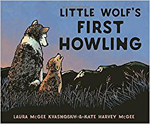 What happens when Little Wolf insists on adding his own special twist to the typical wolf howl? Little Wolf and his father, Big Wolf, set off into the forest for Little Wolf’s first howling lesson. Despite Big Wolf’s strong examples of a proper howl, Little Wolf can’t help but include some jazzy, scat-style additions to create his signature wolf howl. “Aaaaaooooooo dibbity dobbity skibbity skobbity skooo-wooooo-woooooo!” Young children will delight in joining in the howling fun of this read-aloud story. Gouache illustrations with digital coloring evoke a washed-in-moonlight look to this story of an eventful evening in Little Wolf’s life.
What happens when Little Wolf insists on adding his own special twist to the typical wolf howl? Little Wolf and his father, Big Wolf, set off into the forest for Little Wolf’s first howling lesson. Despite Big Wolf’s strong examples of a proper howl, Little Wolf can’t help but include some jazzy, scat-style additions to create his signature wolf howl. “Aaaaaooooooo dibbity dobbity skibbity skobbity skooo-wooooo-woooooo!” Young children will delight in joining in the howling fun of this read-aloud story. Gouache illustrations with digital coloring evoke a washed-in-moonlight look to this story of an eventful evening in Little Wolf’s life.
—JS
Penguin Day: A Family Story. Nic Bishop. 2017. Scholastic.
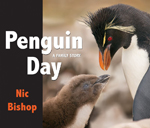 Award-winning nature photographer Nic Bishop took his camera to Antarctica to capture the images of rockhopper penguins featured in Penguin Day. With stunning close-up color photographs and a simple narrative, Bishop presents a day in the life of a family of penguins. Baby penguin waits for mama penguin to return from a day of hunting at sea to bring home food. Papa penguin stays nearby and helps make sure that baby penguin stays safe. Upon mama penguin’s return, baby penguin gets a meal of regurgitated food, and it’s time to sleep. There is a brief note on Bishop’s experiences photographing a colony of penguins for this story in Antarctica. An author’s note includes more information about southern rockhopper penguins.
Award-winning nature photographer Nic Bishop took his camera to Antarctica to capture the images of rockhopper penguins featured in Penguin Day. With stunning close-up color photographs and a simple narrative, Bishop presents a day in the life of a family of penguins. Baby penguin waits for mama penguin to return from a day of hunting at sea to bring home food. Papa penguin stays nearby and helps make sure that baby penguin stays safe. Upon mama penguin’s return, baby penguin gets a meal of regurgitated food, and it’s time to sleep. There is a brief note on Bishop’s experiences photographing a colony of penguins for this story in Antarctica. An author’s note includes more information about southern rockhopper penguins.
—JS
Robins!: How They Grow Up. Eileen Christelow. 2017. Clarion/Houghton Mifflin Harcourt.
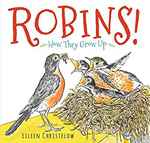 Robins rule the roost in this carefully researched picture book narrated by two “teenage” robins. Details in Christelow’s sequential art panels and digital sketch-like illustrations add both humor and information to the text. Christelow doesn’t shy away from gory details as one of the eggs is taken by a squirrel and one of the babies is snatched up by a hawk, leaving only two survivors to tell the story of their first year of life. Back matter includes a glossary, a question and answer section, and a short reference list. This is a great book for young birdwatchers, especially those with robins in their yard.
Robins rule the roost in this carefully researched picture book narrated by two “teenage” robins. Details in Christelow’s sequential art panels and digital sketch-like illustrations add both humor and information to the text. Christelow doesn’t shy away from gory details as one of the eggs is taken by a squirrel and one of the babies is snatched up by a hawk, leaving only two survivors to tell the story of their first year of life. Back matter includes a glossary, a question and answer section, and a short reference list. This is a great book for young birdwatchers, especially those with robins in their yard.
—JS
The Secret Life of the Red Fox. Laurence Pringle. Ill. Kate Garchinsky. 2017. Boyds Mills/Highlights.
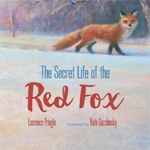 This informational picture book follows a year in the life of an elusive red fox named Vixen as she survives a cold winter, finds a mate, gives birth to four pups, and raises them until they are are ready to go off on their own. Beautiful illustrations, created with pastels and aqua crayons on sanded paper, give the story a soft, muted feel. Back matter includes an author’s note with more information on the red fox, a glossary, and a short list of books about foxes for interested readers.
This informational picture book follows a year in the life of an elusive red fox named Vixen as she survives a cold winter, finds a mate, gives birth to four pups, and raises them until they are are ready to go off on their own. Beautiful illustrations, created with pastels and aqua crayons on sanded paper, give the story a soft, muted feel. Back matter includes an author’s note with more information on the red fox, a glossary, and a short list of books about foxes for interested readers.
—JS
Ages 9–11
Dino Records: The Most Amazing Prehistoric Creatures Ever to Have Lived on Earth! Jen Agresta & Avery Elizabeth Hurt. 2017. National Geographic Kids.
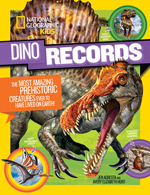 This fascinating book about “the most amazing prehistoric creatures ever to have lived on Earth” is perfect for readers who think they know all there is to know about dinosaurs. Following a brief introduction and a double-spread timeline of the Mesozoic Era, the book is organized in seven chapters: “Biggest,” “Smallest,” “Deadliest,” “Weirdest,” “Most Intriguing,” “First,” and “Prehistoric Animals.” Each chapter introduces a winner and several runner-ups. For example, the winner for biggest dinosaur is the Titanosaur and for smallest, the Microraptor. Other sections include a “Creature Feature,” a “Flashforward” on a modern living relative, and a “Fun and Games” quiz.
This fascinating book about “the most amazing prehistoric creatures ever to have lived on Earth” is perfect for readers who think they know all there is to know about dinosaurs. Following a brief introduction and a double-spread timeline of the Mesozoic Era, the book is organized in seven chapters: “Biggest,” “Smallest,” “Deadliest,” “Weirdest,” “Most Intriguing,” “First,” and “Prehistoric Animals.” Each chapter introduces a winner and several runner-ups. For example, the winner for biggest dinosaur is the Titanosaur and for smallest, the Microraptor. Other sections include a “Creature Feature,” a “Flashforward” on a modern living relative, and a “Fun and Games” quiz.
—CA
Insects (Ultimate Explorer Field Guide). Libby Romero. 2017. National Geographic Kids.
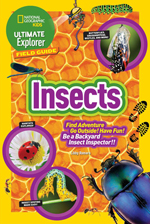 Following a brief introduction about insects, where to find them, insect protection, and how to use the book, this field guide is organized into two sections based on the type of metamorphosis insects go through. Each entry includes a color photograph of the insect with key features labeled; a listing of its common and scientific names, size, habitat, and range; and a paragraph about its characteristics and behaviors. Boxed, color-coded inserts offer tips for quick identification of the species, activities, insect facts, and jokes and riddles. “Information Reports” feature topics such as bugs vs. insects, invasive species, and the conservation of beneficial insects. Back matter includes a “Quick ID Guide,” resources, a glossary, and an index.
Following a brief introduction about insects, where to find them, insect protection, and how to use the book, this field guide is organized into two sections based on the type of metamorphosis insects go through. Each entry includes a color photograph of the insect with key features labeled; a listing of its common and scientific names, size, habitat, and range; and a paragraph about its characteristics and behaviors. Boxed, color-coded inserts offer tips for quick identification of the species, activities, insect facts, and jokes and riddles. “Information Reports” feature topics such as bugs vs. insects, invasive species, and the conservation of beneficial insects. Back matter includes a “Quick ID Guide,” resources, a glossary, and an index.
—CA
Ages 12–14
Amazon Adventure: How Tiny Fish Are Saving the World’s Largest Rainforest (Scientists in the Field). Sy Montgomery. Ill. Keith Ellenbogen. 2017. Houghton Mifflin Harcourt.
 In their latest collaboration in the Scientists in the Field series, author Sy Montgomery and nature photographer Keith Ellengoben travel up the Río Negro and through Amazonian rainforests. They have joined Scott Dowd, senior aquarist at Boston’s New England Aquarium and the Project Piaba team, in studying piabas (tiny ornamental fish sold to aquarists around the world). The region’s small towns depend on income from the global exportation of piabas—which also help sustain the Amazon’s biodiversity. Amazon Adventure focuses on both the biology of the tiny fish and on the work of scientists and local fisherman to improve the fishery industry. Each chapter concludes with a catchy insert such as “Amazon by the Numbers” and “Meeting the Seven Deadly Plagues of the Amazon—in the Dark!” Back matter includes a bibliography, web resources, and an index.
In their latest collaboration in the Scientists in the Field series, author Sy Montgomery and nature photographer Keith Ellengoben travel up the Río Negro and through Amazonian rainforests. They have joined Scott Dowd, senior aquarist at Boston’s New England Aquarium and the Project Piaba team, in studying piabas (tiny ornamental fish sold to aquarists around the world). The region’s small towns depend on income from the global exportation of piabas—which also help sustain the Amazon’s biodiversity. Amazon Adventure focuses on both the biology of the tiny fish and on the work of scientists and local fisherman to improve the fishery industry. Each chapter concludes with a catchy insert such as “Amazon by the Numbers” and “Meeting the Seven Deadly Plagues of the Amazon—in the Dark!” Back matter includes a bibliography, web resources, and an index.
—CA
American Pharoah: Triple Crown Champion. Shelley Fraser Mickle. 2017. Aladdin/Simon & Shuster.
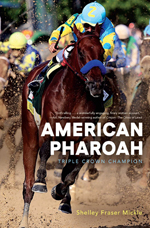 Everyone loves an underdog—or in this case—an underhorse! This nonfiction chapter book details the life of American Pharoah, a thoroughbred who won the rare title of Triple Crown Champion in 2015, despite having a misspelled name, a chewed-off tail, and an aversion to loud noises. Mickle weaves in additional narratives of the people who played important roles in American Pharoah’s life, including jockey Victor Espinoza, owner Amahd Zayat, and trainer Bob Baffert. Extensive back matter includes an epilogue, an author’s note, a glossary of equestrian terms, and even some of the messages that people wrote to American Pharoah, congratulating the horse for his inspirational victory.
Everyone loves an underdog—or in this case—an underhorse! This nonfiction chapter book details the life of American Pharoah, a thoroughbred who won the rare title of Triple Crown Champion in 2015, despite having a misspelled name, a chewed-off tail, and an aversion to loud noises. Mickle weaves in additional narratives of the people who played important roles in American Pharoah’s life, including jockey Victor Espinoza, owner Amahd Zayat, and trainer Bob Baffert. Extensive back matter includes an epilogue, an author’s note, a glossary of equestrian terms, and even some of the messages that people wrote to American Pharoah, congratulating the horse for his inspirational victory.
—JS
Wicked Bugs: The Meanest, Deadliest, Grossest Bugs on Earth. Amy Stewart. Ill. Briony Morrow-Gribbs. 2017. Algonquin.
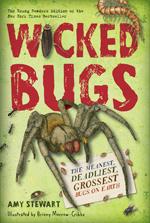 This young readers’ edition of Wicked Bugs: The Louse That Conquered Napoleon’s Army and Other Diabolical Insects (2011) includes introductory notes on the widespread use of the word “bugs” to refer to insects, spiders, and other creatures in the book and scientific classification. Stewart presents more than 100 “wicked bugs” (including assassin bugs, mountain pine beetles, giant centipedes, and black widows) and their roles in human history. The entries are organized into five sections: "Deadly Creatures," "Everyday Dangers," "Unwelcome Invaders," "Serious Pains," and "Terrible Threats." Each of the four to six examples in a section features the bug’s common and scientific names; an illustration; and an inset listing size, family, habitat, distribution, and relatives. Dropped quotes draw the reader into the text. Back matter includes a list of bug-related phobias, a glossary, resources, a bibliography, and an index. This book is informative, fascinating and—as promised by the title—often creepy, terrifying, and disgusting.
This young readers’ edition of Wicked Bugs: The Louse That Conquered Napoleon’s Army and Other Diabolical Insects (2011) includes introductory notes on the widespread use of the word “bugs” to refer to insects, spiders, and other creatures in the book and scientific classification. Stewart presents more than 100 “wicked bugs” (including assassin bugs, mountain pine beetles, giant centipedes, and black widows) and their roles in human history. The entries are organized into five sections: "Deadly Creatures," "Everyday Dangers," "Unwelcome Invaders," "Serious Pains," and "Terrible Threats." Each of the four to six examples in a section features the bug’s common and scientific names; an illustration; and an inset listing size, family, habitat, distribution, and relatives. Dropped quotes draw the reader into the text. Back matter includes a list of bug-related phobias, a glossary, resources, a bibliography, and an index. This book is informative, fascinating and—as promised by the title—often creepy, terrifying, and disgusting.
—CA
Ages 15+
The Photo Ark: One Man’s Quest to Document the World’s Animals. Joel Sartore. 2017. National Geographic.
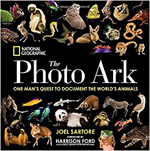 The Photo Ark is an amazing pictorial encyclopedia showcasing the diversity of animals on our planet. The book features portraits of more than 400 animals by National Geographic photographer Joel Sartore, who thinks of himself as “an animal ambassador, a voice for the voiceless.” Working with captive animals, Sartore photographed each species against a black or white background under controlled lighting to bring out details. Each photo is captioned with the common and the scientific name of the animal and the species conservation status. Sartore includes thought-provoking pairings of portraits that focus on particular features, for example, side-by-side photographs of an African leopard and a bobtail squid show a shared camouflaging pattern. The book also includes inserts about eight conservationists working to protect the Earth’s biodiversity. Back matter includes notes on the production of the photographs, National Geographic’s Photo Ark Project, information about Joel Sartore and contributors, acknowledgements, and an index of animals (in order of appearance by common name).
The Photo Ark is an amazing pictorial encyclopedia showcasing the diversity of animals on our planet. The book features portraits of more than 400 animals by National Geographic photographer Joel Sartore, who thinks of himself as “an animal ambassador, a voice for the voiceless.” Working with captive animals, Sartore photographed each species against a black or white background under controlled lighting to bring out details. Each photo is captioned with the common and the scientific name of the animal and the species conservation status. Sartore includes thought-provoking pairings of portraits that focus on particular features, for example, side-by-side photographs of an African leopard and a bobtail squid show a shared camouflaging pattern. The book also includes inserts about eight conservationists working to protect the Earth’s biodiversity. Back matter includes notes on the production of the photographs, National Geographic’s Photo Ark Project, information about Joel Sartore and contributors, acknowledgements, and an index of animals (in order of appearance by common name).
—CA
All Ages
Animals of a Bygone Era: An Illustrated Compendium. Maja Säfström. 2017. Ten Speed/Crown.
 In an introductory letter to the reader, Swedish artist Maja Säfström states she will be presenting “a few of the countless amazing creatures that once roamed the Earth.” What follows are double-page spreads that introduce readers of all ages to 54 extinct animals, some that lived long ago and others that died off recently. Whimsical, detailed black-and-white portraits with handwritten notes point out characteristics and additional facts. In some cases, the animal adds a comment (often a humorous one) in a speech balloon. For example, the Coryphodon, a hippo-like animal that had the smallest brain-to-body ratio of any mammal that has ever lived, says, “I am not intelligent but I’m not that smart either.” Readers will also enjoy Säfström’s The Illustrated Compendium of Amazing Animal Facts (2016).
In an introductory letter to the reader, Swedish artist Maja Säfström states she will be presenting “a few of the countless amazing creatures that once roamed the Earth.” What follows are double-page spreads that introduce readers of all ages to 54 extinct animals, some that lived long ago and others that died off recently. Whimsical, detailed black-and-white portraits with handwritten notes point out characteristics and additional facts. In some cases, the animal adds a comment (often a humorous one) in a speech balloon. For example, the Coryphodon, a hippo-like animal that had the smallest brain-to-body ratio of any mammal that has ever lived, says, “I am not intelligent but I’m not that smart either.” Readers will also enjoy Säfström’s The Illustrated Compendium of Amazing Animal Facts (2016).
—CA
Jennifer W. Shettel is an associate professor at Millersville University of Pennsylvania where she teaches undergraduate and graduate course in literacy for preservice and practicing teachers. Prior to joining the faculty at Millersville, she spent 16 years as an elementary classroom teacher and reading specialist in the public schools. Carolyn Angus is former Director of the George G. Stone Center for Children's Books, Claremont Graduate University, in Claremont, California.
These reviews are submitted by members of the International Literacy Association's Children's Literature and Reading Special Interest Group (CL/R SIG) and are published weekly on Literacy Daily.